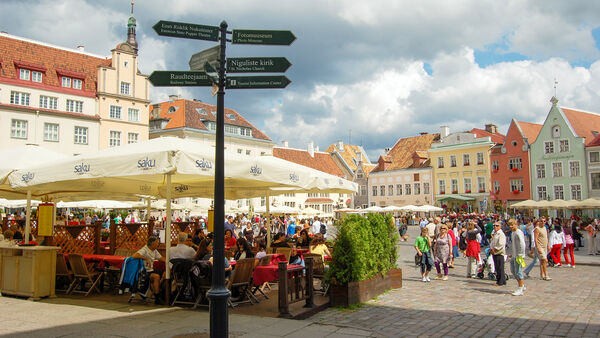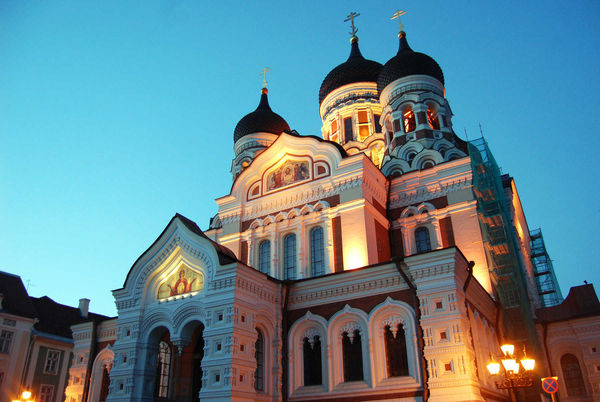A Quick Trip to Tallinn
By Rick Steves


Stepping off the boat in Tallinn, Estonia — a short ferry ride from Helsinki (and an overnight sailing from Stockholm, or an easy flight from anywhere in Europe) — you'll likely feel as if you've nevertheless traveled a great cultural distance from Scandinavia. Located about halfway between Stockholm and St. Petersburg, Tallinn is both Nordic- and Russian-influenced, and a visit here is a fun peek into a proudly unique and resilient nation.
While both Estonia and neighboring Finland gained independence from Sweden, then Russia, after World War I — when Estonians were at least as affluent and as advanced as the Finns — Estonia could not preserve its independence from Soviet expansion during World War II, after which the nation sank into a nearly 50-year period of communist stagnation.
But Estonia's post-communist chapter has been a success story, and since 1991 its capital city has westernized at an astounding rate, all while holding tight to its Old World charm.
Tallinn's mostly intact city wall includes 26 watchtowers, each topped by a pointy red roof. Baroque and choral music ring out from its old Lutheran churches. Below the steeples and towers, the Old Town is crammed with inviting shops and restaurants. Meanwhile, the outlying districts are a Petri dish of architectural experimentation.
Given its compact scale, Tallinn can be easily appreciated as a side-trip (from Helsinki, or from a cruise ship). If you've only got a day, start with a short stroll from the port to the lower end of the Old Town.
Tallinn once consisted of two feuding medieval towns. The lower of the two, the Old Town, was an independent city, a Hanseatic trading center filled with German, Danish, and Swedish merchants who hired Estonians to do their menial labor. The walk to its central square is lined with these medieval merchant traders' home/warehouse/offices, featuring delightful touches from the Hanseatic Golden Age.
Town Hall Square, the focal point of the Old Town, has been a marketplace through the centuries, and still flaunts a cancan of fine old buildings. Once, it held criminals chained to pillories for public humiliation and knights showing off in chivalrous tournaments; today it's full of Scandinavians and Russians savoring cheap beer, children singing on the bandstand, and cruise-ship groups following the numbered paddles carried high by their local guides.
The 15th-century town hall dominating the square is now home to the Tallinn City Museum, which provides a fascinating introduction to Tallinn's glory days as a stronghold of the maritime world. And climbing the town hall's tower earns you a commanding view.
Like many cities' tourist zones, Tallinn's is a commercial gauntlet, with medieval theme restaurants and enthusiastic hawkers of ye olde taste treats. But just a couple of blocks away is, for me, the real attraction of Tallinn, where still-ramshackle courtyards host inviting cafés and bistros with a chic old-meets-new patina.
Uphill from Town Hall Square lies Toompea — the lower town's old rival, and long the seat of the government ruling Estonia. Climbing the stairs from the lower Old Town, you'll notice that the architecture tells a story. For instance, the Alexander Nevsky Cathedral — built by Russians in 1900 — faces the pink palace known as Toompea Castle, which now houses the Estonian Parliament. The cathedral is beautiful, but as it was clearly designed to flex Russian cultural muscles during a period of Estonian national revival, most Estonians don't like it.
Near the cathedral, Tallinn's Vabamu Museum of Occupations and Freedom tells the history of Estonia under Soviet, then Nazi, and once again Soviet occupation. Displays show how Russians kept Estonians in line and focus on the inhumane living conditions in occupied society, stories of Estonians living in exile, and ultimately independence and freedom.
Efficient day-trippers can see all this with time to enjoy lunch in the Old Town, and spend the afternoon either browsing its shops, or heading to one of the city's worthwhile outlying sights: an ambitious nautical-aviation-military museum called Seaplane Harbor, the Rotermann Quarter for its cutting-edge architecture, the Estonian Open-Air Museum for folk culture, or Kumu Art Museum for Estonian art and a walk in nearby Kadriorg Park.
Those who spend the night, however, are rewarded with the option of touring the Old Town early or late, when it's much less crowded. Mid-day is a perfect time to explore some of the sights and more colorful slices of life outside the Old Town walls.
A visit here is logistically easy, with none of the infrastructure hassles you might expect from a post-Soviet city. And nowadays, most Estonians can speak English. Of course, no one expects visitors to arrive having mastered Estonian (a language that's similar to Finnish and equally difficult) — only a million people speak it worldwide. But even on a quick visit at least two words are certainly worth learning: Tänan (TAH-nahn) — "Thank you"…and Terviseks! (TEHR-vee-sehks): "Cheers!"

